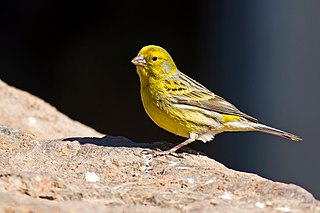
The Atlantic canary, known worldwide simply as the wild canary and also called the island canary, common canary, or canary, is a small passerine bird belonging to the genus Serinus in the finch family, Fringillidae. It is native to the Canary Islands, the Azores, and Madeira. Wild birds are mostly yellow-green, with brownish streaking on the back. The species is common in captivity and a number of colour varieties have been bred.

Macaronesia is a collection of four volcanic archipelagos in the North Atlantic Ocean, off the coasts of the continents of Europe and Africa. Each archipelago is made up of a number of Atlantic oceanic islands, which are formed by seamounts on the ocean floor and have peaks above the ocean's surface. Some of the Macaronesian islands belong to Portugal, some belong to Spain, and the rest belong to Cape Verde. Politically, the islands belonging to Portugal and Spain are part of the European Union. Geologically, Macaronesia is part of the African tectonic plate. Some of its islands - the Azores - are situated along the edge of that plate at the point where it abuts the Eurasian and North American plates.
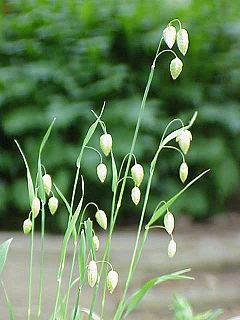
Briza is a genus of annual and perennial plants in the grass family, native to northern temperate regions of Eurasia, North Africa, and certain islands in the Atlantic.
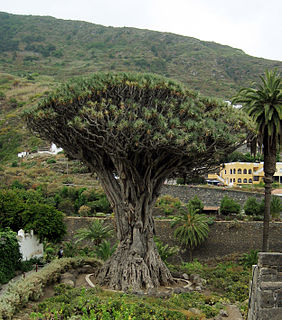
Dracaena draco, the Canary Islands dragon tree or drago, is a subtropical tree in the genus Dracaena, native to the Canary Islands, Cape Verde, Madeira, western Morocco, and is thought to be introduced in the Azores. It is the natural symbol of the island of Tenerife, together with the blue chaffinch. Its closest living relative is the dragon's blood tree of Socotra, Dracaena cinnabari.
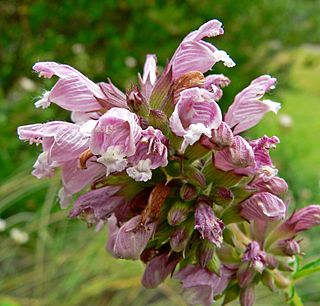
Cedronella is a genus of flowering plants in the tribe Mentheae of the family Lamiaceae, comprising a single species, Cedronella canariensis, native to the Canary Islands, the Azores, and Madeira. It is also naturalized in various places. Common names include Canary Islands-balm, Canary balm, and Balm-of-Gilead.
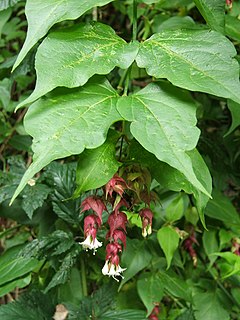
Leycesteria formosa, the Himalayan honeysuckle, flowering nutmeg, Himalaya nutmeg, granny's curls or pheasant berry, is a deciduous shrub in the family Caprifoliaceae, native to the Himalaya and southwestern China. It is considered a noxious invasive species in Australia, New Zealand, the neighbouring islands of Micronesia, and some other places.

Ballota nigra, the black horehound, is a perennial herb of the family Lamiaceae. It is native to the Mediterranean region and to central Asia, and it can be found throughout Europe. It is also naturalized in Argentina, New Zealand, and the Eastern United States. It blooms in the Northern Hemisphere from May to August.

Ocotea foetens, commonly called til or stinkwood is a species of tree in the family Lauraceae. It is evergreen and grows up to 40 m tall. It is a common constituent of the laurisilva forests of Madeira and the Canary Islands. Leaf fossils of this species are known from the Mio-Pleistocene of Madeira Island.

Sideroxylon mirmulans, commonly known as marmulano, is a species of flowering plants in the family Sapotaceae. It is endemic to the Madeira Islands (Portugal). It is threatened by habitat loss.

Vulpia is a widespread genus of plants in the grass family, native to many countries around the world and naturalized in many of the nations to which it is not native. It is most common in temperate regions.

Hypericum canariense is a species of flowering plant in the family Hypericaceae known by the common name Canary Islands St. John's wort. It is the sole member of Hypericumsect. Webbia.
Triplachne is a genus of seaside plants in the grass family, native to shorelines in the Mediterranean region from the Canary Islands to Turkey. The only known species is Triplachne nitens, called shining grass. It is native to Spain, Portugal, Sicily, Greece, Algeria, Morocco, Libya, Tunisia, Egypt, Turkey, Cyprus, Palestine, Israel.
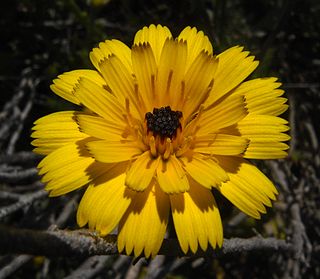
Tolpis is a genus of flowering plants in the dandelion tribe within the daisy family. Many species are limited to the Canary Islands.

Bystropogon is a genus of evergreen shrubs in the family Lamiaceae. It is native to the Canary Islands and Madeira in the western Atlantic Ocean. Allied to the Origanum and Thymus, the genus is characterized by tiny flowers in much-branched clusters, with plume-like sepals that elongate at the fruiting stage, giving the whole tip of each branch a fuzzy appearance. Stems are square in cross-section and leaves, arranged in opposite pairs, are aromatic when crushed.

Globularia salicina is a shrub native to the archipelago of Madeira and to the central and western Canary Islands.
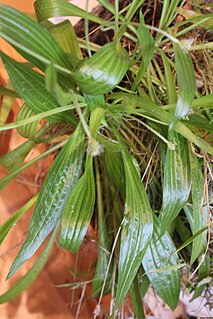
Plantago leiopetala is a herbaceous perennial, caulescent with a thick woody, white pubescent stem up to 6 cm in height, bearing the bases of old petioles and scapes. Lanceolate, glabrous or glabrescent leaves up to 21 cm in length, borne in rosette at end of stem. Spikes, 1–3 cm, supported by scapes, 30 cm in length. Flowers with generally glabrous sepals, sometimes shortly villous above, corolla-lobes 2.1–3 mm. Flowers from March to July.

Phyllis nobla is a small, glabrous or pubescent subshrub in the family Rubiaceae.

Phyllis viscosa is like Phyllis nobla but smaller with narrow, sticky leaves and short, dense inflorescence.

Salix pedicellata is a species of willow. It is a shrub or small tree to about 6–8 m tall, native around the Mediterranean Sea from Portugal to Lebanon and Syria in the north and from the Canary Islands to Tunisia in the south. Salix canariensis may be treated as a subspecies of S. pedicellata.

Cistanche phelypaea or Cistanche phelipaea is a species of plant in the family Orobanchaceae. It has a wide range of distribution from the Arabian Peninsula and the Syrian Desert in the east, through the Sahara, Cyprus, Crete and the southwest of the Iberian Peninsula, to Macaronesia in the west.




















